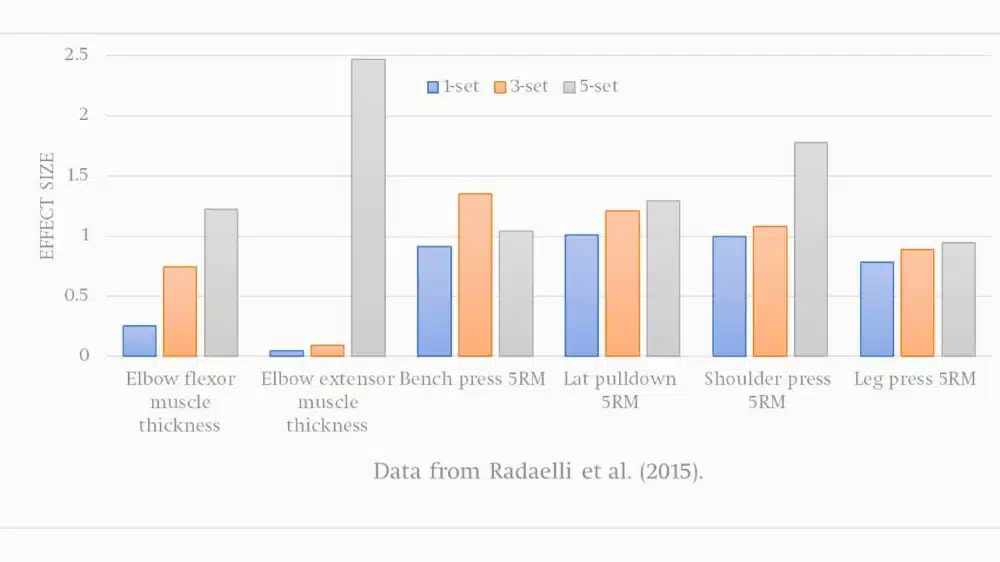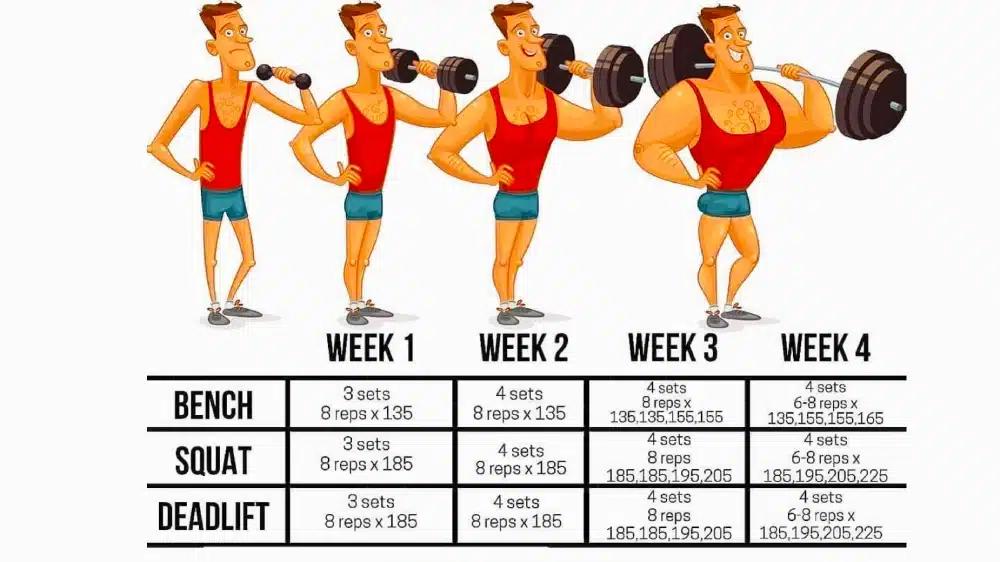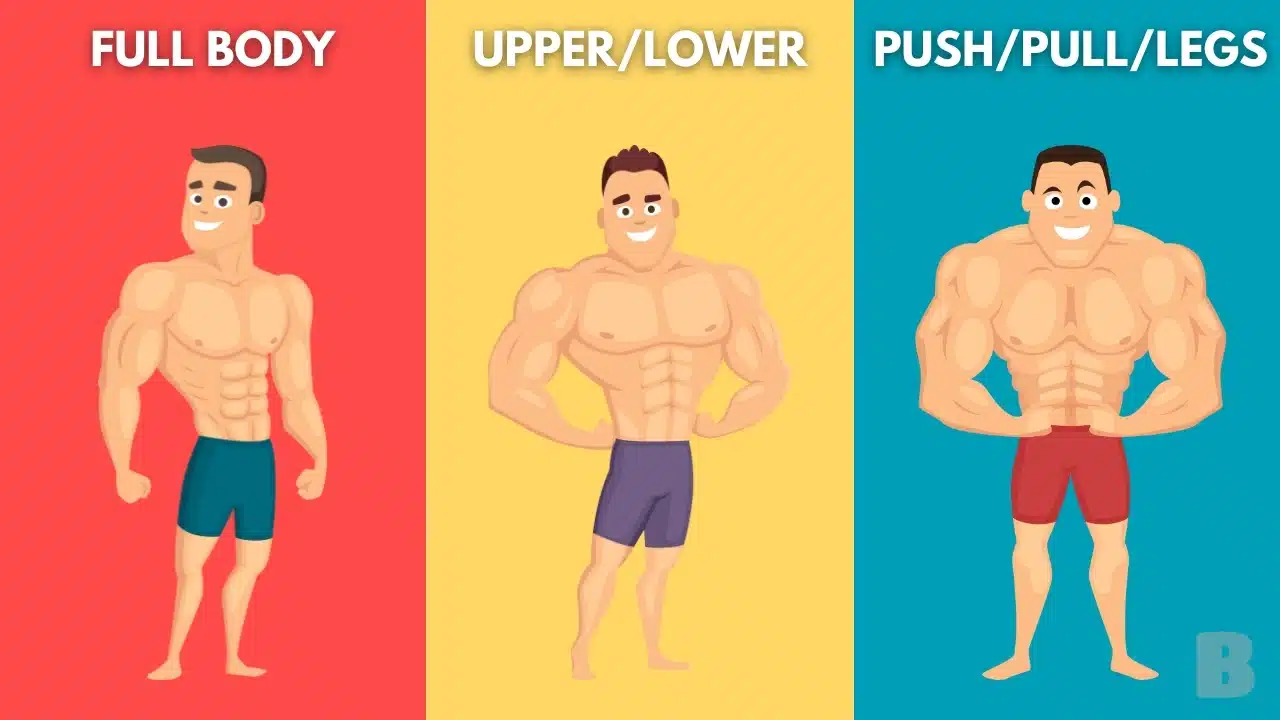Choosing the right workout split is your key to accelerate muscle growth. But with so many options, where do you start?
Discover three powerful, science-backed workout splits: the Upper/Lower Split, the Push/Pull/Legs Split, and the Full-Body Split. Each offers unique advantages, depending on your goals and experience level.
Learn the secrets behind each split – how they work, who they’re best for, and why they could be the ideal approach to supercharging your results.
Jump to:
Key Factors for Maximizing Muscle Growth
Training Frequency

Research underscores the significance of training frequency for muscle hypertrophy. Studies advocate for engaging muscle groups multiple times weekly, diverging from the traditional once-a-week regimen.
Evidence indicates that training a muscle group at least twice a week promotes superior hypertrophic outcomes compared to training once a week, implying that major muscle groups should be trained at least twice a week to maximize growth.
Whether training a muscle group three times per week provides additional benefits compared to twice per week remains to be determined (Schoenfeld, Ogborn, & Krieger, 2016).
Training Volume

Training volume, encompassing sets and repetitions per muscle group, is paramount for muscle gains. Recent evidence suggests that higher volumes might accelerate hypertrophy.
Research suggests that the frequency of resistance training does not significantly or meaningfully impact muscle hypertrophy when volume is equated, meaning for a given training volume, weekly frequency per muscle group can be chosen based on personal preference (Schoenfeld, Grgic, & Krieger, 2019)
However, it’s crucial to balance intensity to prevent overtraining and ensure recovery.
Progressive Overload

The principle of progressive overload remains a cornerstone for muscle growth. This approach entails progressively increasing the weight, reps, or intensity of exercises to challenge muscles continually.
Its effectiveness is well-documented, with numerous studies highlighting its role in advancing strength and hypertrophy over time.
A study found that both increasing load while keeping repetition range constant and increasing repetitions while keeping load constant are viable strategies for enhancing muscular adaptations over an 8-week training cycle. This suggests that trainers and trainees have flexibility in programming resistance training to achieve hypertrophy and strength gains (Plotkin et al., 2022).
Individualization
Finally, the concept of individualization in training cannot be overstated. Optimal training splits are highly personal, varying significantly across individuals based on factors such as experience, goals, and recovery abilities.
Studies indicate that individualization in strength training, whether through personalizing training sessions in small groups or tailoring programs to athletes’ specific needs, can lead to improved motivation, self-efficacy, psychomotor performance, and overall satisfaction with training. (Kozina, Sobko, Tatyana, R. Olena, Lachno, & I. Anna, 2015).
Evidence-Based Strength Training Splits
Optimal strength training splits are pivotal for maximizing muscle gains. This section delves into three proven splits, each tailored to different training levels and schedules.
Full-Body Splits (3-4 days per week)
Structure: Full-body splits are structured around compound movements that target all major muscle groups in each session. Workouts are spread across 3 to 4 days a week, ensuring each muscle group receives attention multiple times weekly.
Benefits: This approach is highly efficient, making it especially beneficial for beginners or those with limited time. It promotes frequent stimulation of all muscle groups, which can lead to rapid improvements in strength and muscle mass for newcomers.
Ideal for: Beginners will find full-body splits an excellent starting point, but they’re also suitable for those with more experience seeking an efficient training regime due to time constraints.
Full-Body Split Routine
Day 1
- Squats (Barbell or Dumbbell): 3 sets of 6-8 reps
- Overhead Press (Barbell or Dumbbell): 3 sets of 8-10 reps
- Pull-Ups (or Assisted Pull-ups): 3 sets to near failure
- Romanian Deadlifts (RDLs): 3 sets of 8-10 reps
- Bicep Curls: 2 sets of 10-12 reps
- Tricep Extensions: 2 sets of 10-12 reps
Day 2
- Bench Press (Barbell or Dumbbell): 3 sets of 6-8 reps
- Barbell Rows: 3 sets of 8-10 reps
- Lunges (Weighted or Bodyweight): 3 sets of 8-10 reps per leg
- Leg Press: 3 sets of 10-12 reps
- Plank (hold for 30-60 seconds): 3 sets
Day 3: Rest or Active Recovery (Light Cardio/Mobility)
Day 4
- Deadlifts: 3 sets of 5-7 reps
- Incline Dumbbell Press: 3 sets of 8-10 reps
- Wide-Grip Pull-ups (or Lat Pulldown): 3 sets to near failure
- Bulgarian Split Squat: 3 sets of 8-10 reps per leg
- Hammer Curls: 2 sets of 10-12 reps
- Overhead Triceps Extensions: 2 sets of 10-12 reps
Upper/Lower Splits (4 days per week)
Structure: This split divides workouts into upper body and lower body sessions. A typical week might look like this: Upper Body Day 1, Lower Body Day 2, Rest, Upper Body Day 3, Lower Body Day 4. This arrangement ensures each major muscle group is trained twice weekly.
Benefits: The upper/lower split allows for focused training sessions, giving each muscle group adequate attention and recovery time. It’s particularly effective for enhancing strength and building muscle due to the balanced approach to training frequency.
Ideal for: Lifters at intermediate and advanced levels will find this split offers the perfect blend of intensity and recovery.
Upper/Lower Split Routine
Day 1: Upper Body
- Bench Press: 3 sets of 6-8 reps
- Barbell Row: 3 sets of 6-8 reps
- Overhead Press: 3 sets of 8-10 reps
- Pull-ups (or Assisted Pull-Ups): 3 sets to near failure
- Bicep Curls: 3 sets of 10-12 reps
- Triceps Pushdowns: 3 sets of 10-12 reps
Day 2: Lower Body
- Squats: 3 sets of 6-8 reps
- Deadlifts: 3 sets of 5-7 reps
- Leg Press: 3 sets of 10-12 reps
- Hamstring Curls: 3 sets of 10-12 reps
- Calf Raises: 3 sets of 15-20 reps
Day 3: Upper Body
- Incline Dumbbell Press: 3 sets of 6-8 reps
- Wide-Grip Pull-ups (or Lat Pulldown): 3 sets to near failure
- Dips: 3 sets to near failure
- Lateral Raises: 3 sets of 12-15 reps
- Overhead Triceps Extensions: 3 sets of 10-12 reps
- Hammer Curls: 3 sets of 10-12 reps
Day 4: Lower Body
- Front Squats: 3 sets of 6-8 reps
- Romanian Deadlifts (RDLs): 3 sets of 8-10 reps
- Bulgarian Split Squats: 3 sets of 8-10 reps per leg
- Leg Extensions: 3 sets of 10-12 reps
- Seated Calf Raises: 3 sets of 15-20 reps
Push/Pull/Legs (5-6 days per week)
Structure: The push/pull/legs split organizes workouts by movement patterns. Push days focus on exercises that involve pushing movements, targeting the chest, shoulders, and triceps. Pull days cover pulling movements, working the back and biceps. Legs days are dedicated to the lower body. The cycle is typically followed by a rest day, then repeated.
Benefits: This split allows for a higher training volume for each muscle group, which is crucial for muscle growth. By concentrating on specific action patterns, it ensures a comprehensive workout for all involved muscles, maximizing stimulation.
Ideal for: Geared towards intermediate and advanced lifters ready to commit to a more demanding training schedule, this split accelerates muscle growth through increased frequency and volume.
6-Day Push/Pull/Legs Split Routine
Day 1: Push (Chest, Shoulders, Triceps)
- Barbell Bench Press: 3 sets of 5-7 reps
- Incline Dumbbell Press: 3 sets of 8-10 reps
- Decline Dumbbell Press: 3 sets of 10-12 reps
- Overhead Press (Barbell or Dumbbell): 3 sets of 8-10 reps
- Triceps Pushdowns (Rope Attachment): 3 sets of 12-15 reps
- Lateral Raises: 3 sets of 12-15 reps
Day 2: Pull (Back, Biceps)
- Weighted Pull-ups: 3 sets of 5-7 reps
- Barbell Rows: 3 sets of 8-10 reps
- Lat Pulldown: 3 sets of 10-12 reps
- Bicep Curls (Barbell or Dumbbell): 3 sets of 10-12 reps
- Hammer Curls: 3 sets of 10-12 reps
Day 3: Legs (Quads, Hamstrings, Glutes, Calves)
- Back Squats: 3 sets of 5-7 reps
- Leg Press: 3 sets of 8-10 reps
- Romanian Deadlifts (RDLs): 3 sets of 10-12 reps
- Leg Extensions: 3 sets of 12-15 reps
- Hamstring Curls: 3 sets of 12-15 reps
- Calf Raises (Standing or Seated): 3 sets of 15-20 reps
Day 4: Rest or Active Recovery (Light Cardio/Mobility)
Day 5: Push (Chest, Shoulders, Triceps)
- Incline Dumbbell Bench Press: 3 sets of 5-7 reps
- Flat Dumbbell Press: 3 sets of 8-10 reps
- Dips: 3 sets to near failure
- Military Press (Barbell or Dumbbell): 3 sets of 8-10 reps
- Close-Grip Bench Press: 3 sets of 10-12 reps
- Triceps Overhead Extensions: 3 sets of 12-15 reps
Day 6: Pull (Back, Biceps)
- Bent-Over Rows: 3 sets of 5-7 reps
- T-Bar Rows: 3 sets of 8-10 reps
- Seated Cable Rows: 3 sets of 10-12 reps
- Preacher Curls: 3 sets of 10-12 reps
- Reverse Grip Barbell Curls: 3 sets of 10-12 reps
Day 7: Rest
Advanced Techniques for Accelerated Growth
Compound Lifts as the Base
Prioritizing compound exercises like squats, deadlifts, bench press, rows, and overhead press is pivotal for maximizing muscle recruitment.
These movements engage multiple muscle groups simultaneously, offering a more efficient and effective workout.
Hypertrophy-Specific Training
Hypertrophy-specific training, focusing on higher rep ranges of 8-15 with shorter rest intervals, targets muscle growth directly.
This strategy contrasts with purely strength-oriented training, which typically involves lower rep counts and longer rest periods.
The methodology leverages metabolic stress and muscle fatigue as catalysts for growth, making it a potent component of an advanced lifting program.
Intra-Workout Nutrition
The role of intra-workout nutrition, particularly the intake of protein and carbohydrates during training sessions, cannot be understated.
This practice fuels the muscles with immediate energy and aids in the repair process, potentially accelerating gains.
Incorporating a balanced blend of fast-absorbing proteins and simple carbohydrates can make a significant difference in workout performance and muscle development outcomes.
Considerations Beyond the Workout Split
Sleep and Recovery
Quality sleep and active recovery are paramount for optimal muscle growth, a fact reinforced by a plethora of recent studies.
Active recovery techniques, such as light exercise, stretching, and mobility work, further aid in reducing muscle soreness and enhancing blood flow to the muscles, facilitating quicker recovery.
These elements combined ensure that the body is fully prepared and in an optimal state for muscle hypertrophy.
Nutrition
Proper nutrition serves as the foundation for muscle building, with a focus on achieving a calorie surplus and ensuring adequate protein intake. To support hypertrophy, consuming more calories than expended is essential.
This energy surplus provides the necessary fuel for workouts and the muscle repair process. Protein plays a critical role in muscle repair and growth, with studies suggesting a target intake of 1.6 to 2.2 grams of protein per kilogram of body weight per day for those engaging in regular strength training.
Sources such as lean meats, dairy, legumes, and protein supplements can help meet this requirement.
Moreover, the timing of protein intake, especially post-workout, can enhance muscle protein synthesis, offering an additional boost to muscle growth efforts.
References:
- Schoenfeld, Brad J et al. “Effects of Resistance Training Frequency on Measures of Muscle Hypertrophy: A Systematic Review and Meta-Analysis.” Sports medicine (Auckland, N.Z.) vol. 46,11 (2016): 1689-1697. doi:10.1007/s40279-016-0543-8
- Schoenfeld, Brad Jon et al. “How many times per week should a muscle be trained to maximize muscle hypertrophy? A systematic review and meta-analysis of studies examining the effects of resistance training frequency.” Journal of sports sciences vol. 37,11 (2019): 1286-1295. doi:10.1080/02640414.2018.1555906
- Plotkin D, Coleman M, Van Every D, Maldonado J, Oberlin D, Israetel M, Feather J, Alto A, Vigotsky AD, Schoenfeld BJ. 2022. Progressive overload without progressing load? The effects of load or repetition progression on muscular adaptations. PeerJ 10:e14142 https://doi.org/10.7717/peerj.14142
- Zhanneta, K., Irina, S., Tatyana, B.N., Olena, R.S., Olena, L., & Anna, I. (2015). The Applying of the Concept of Individualization in Sport. Journal of physical education and sport, 15, 172.
- Geisler, C.; Prado, C.M.; Müller, M.J. Inadequacy of Body Weight-Based Recommendations for Individual Protein Intake—Lessons from Body Composition Analysis. Nutrients 2017, 9, 23. https://doi.org/10.3390/nu9010023














